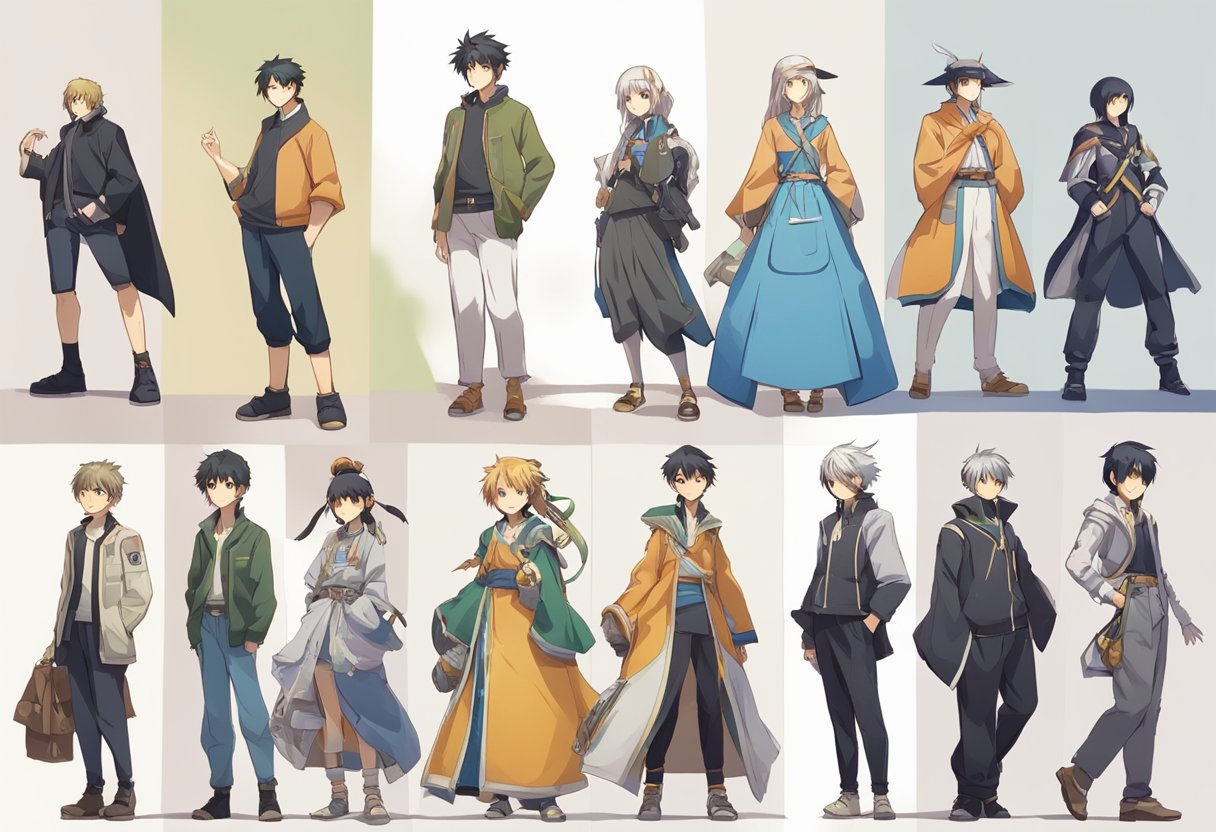Types Of Anime
Anime, a unique style of Japanese animation, has become increasingly popular around the world. With its distinctive art style, engaging storylines, and diverse genres, anime has something to offer for everyone. Whether you are a fan of action, romance, comedy, or drama, there is an anime out there that will capture your interest.
The historical evolution of anime is a fascinating subject that dates back to the early 1900s. Since then, anime has evolved into a global phenomenon, with millions of fans around the world. Major anime genres include action, adventure, comedy, drama, fantasy, horror, mystery, psychological, romance, sci-fi, and supernatural. Each genre has its own unique style and themes, making anime a diverse and engaging medium.
Anime format and distribution have also evolved over the years, with streaming services like Netflix, Hulu, and Crunchyroll making it easier than ever to access anime from anywhere in the world. The cultural impact of anime is also worth noting, as it has influenced everything from fashion to music to video games. Notable anime works include classics like “Dragon Ball Z” and “Sailor Moon” as well as newer hits like “Attack on Titan” and “My Hero Academia.”
Key Takeaways
- Anime is a unique style of Japanese animation that has become increasingly popular around the world.
- Major anime genres include action, adventure, comedy, drama, fantasy, horror, mystery, psychological, romance, sci-fi, and supernatural.
- Anime has had a significant cultural impact and notable works include classics like “Dragon Ball Z” and “Sailor Moon” as well as newer hits like “Attack on Titan” and “My Hero Academia.”
Historical Evolution of Anime

Anime has a rich history that spans over a century, and it has undergone significant changes over time. This section will explore the early beginnings of anime and how it spread internationally.
Early Beginnings
Japanese animation, also known as anime, has its roots in manga, which are Japanese comics. The first anime was produced in 1907, and it was a short film called Katsudo Shashin. It was a black and white film that featured a boy in a sailor suit drawing the characters for Katsudo Shashin. The film was discovered in 2005, and it is considered the first anime ever produced.
In the 1960s and 1970s, anime began to gain popularity in Japan, and it was during this period that anime creators began to explore more complex storytelling techniques and unique character designs. This period is often referred to as the “Golden Age” of anime.
International Spread
Anime began to spread internationally in the 1980s, and it gained popularity in countries like the United States. One of the most popular anime franchises in the world is Pokemon, which was first introduced in Japan in 1996. Pokemon is a media franchise that includes video games, anime, manga, and trading cards.
Another popular anime franchise is Doraemon, which was first introduced in Japan in 1969. Doraemon is a robotic cat from the future who travels back in time to help a young boy named Nobita. The franchise has been adapted into anime, manga, and films, and it is popular in many countries.
Digimon is another popular anime franchise that was first introduced in Japan in 1997. Digimon is a media franchise that includes video games, anime, manga, and trading cards. The franchise follows a group of children who enter a digital world and befriend creatures called Digimon.
In conclusion, anime has a rich history that spans over a century, and it has undergone significant changes over time. It began as a form of Japanese animation that was heavily influenced by manga, and it has since spread internationally and become a global phenomenon.
Major Anime Genres
Anime encompasses a wide range of genres, and the content is often targeted towards specific demographics. Some of the major anime genres are Shonen, Shojo, Seinen, and Josei.
Shonen
Shonen anime is targeted towards young male audiences. It typically features action-packed storylines with male protagonists, and the themes often revolve around adventure, competition, and overcoming obstacles. Examples of popular shonen anime include Naruto, One Piece, and Dragon Ball Z.
Shojo
Shojo anime is targeted towards young female audiences. The themes in shojo anime often revolve around romance, drama, and relationships. The storylines often feature female protagonists, and the animation style is often characterized by bright colors and soft lines. Examples of popular shojo anime include Sailor Moon, Fruits Basket, and Ouran High School Host Club.
Seinen
Seinen anime is targeted towards young adult male audiences. The themes in seinen anime often revolve around more mature topics, such as violence, politics, and uality. The animation style is often more realistic and less exaggerated than shonen anime. Examples of popular seinen anime include Attack on Titan, Death Note, and Cowboy Bebop.
Josei
Josei anime is targeted towards adult women audiences. The themes in josei anime often revolve around more mature topics, such as relationships, career, and family life. The animation style is often more realistic and less exaggerated than shojo anime. Examples of popular josei anime include Nana, Paradise Kiss, and Chihayafuru.
Anime genres are diverse, and there is something for everyone. Whether you are interested in action, adventure, comedy, romance, drama, fantasy, horror, science fiction, or historical themes, there is an anime genre that will suit your preferences.
Anime Format and Distribution
Anime comes in various formats and can be distributed through multiple channels. In this section, we will discuss the three primary formats of anime distribution: Television Series, Movies, and Web Series.
Television Series
Anime television series are the most common format of anime distribution. They are broadcasted on television channels in Japan and are later distributed worldwide through various channels. The episodes are usually 20-25 minutes long and are aired weekly. Some popular anime streaming services for television series include Crunchyroll and Funimation, while DVDs and Blu-rays are also available for purchase.
Movies
Anime movies are usually longer than television series and are released in theaters in Japan before being distributed worldwide. These movies are often a continuation of an anime television series or an adaptation of a manga series. Some popular anime movies include Your Name, Spirited Away, and Akira. Anime movies are also available on streaming services like Netflix and Amazon Prime Video.
Web Series
Web series are a relatively new format of anime distribution and are often released directly on streaming platforms. These series are usually shorter than television series and are released in a season format. Some popular anime web series include One Punch Man and Attack on Titan: Junior High. Streaming services like Crunchyroll and Funimation are the primary distribution channels for anime web series.
In conclusion, anime comes in various formats and can be distributed through multiple channels. Streaming services like Crunchyroll and Funimation have made anime more accessible worldwide, while DVDs and Blu-rays are still popular among anime fans. Television series, movies, and web series are the primary formats of anime distribution and offer different viewing experiences for anime fans.
Cultural Impact and Themes
Influence on Pop Culture
Anime has had a significant impact on pop culture worldwide. It has become a popular form of entertainment and has influenced various aspects of popular culture, including music, fashion, and art. The anime industry has also contributed significantly to the economy of Japan, with anime-related products and merchandise generating billions of dollars in revenue each year.
One of the reasons for anime’s popularity is its ability to appeal to a wide range of audiences. Anime has something for everyone, from children’s shows to adult-oriented programming. This versatility has allowed anime to become a global phenomenon, with fans from all over the world.
Recurring Themes
Anime is known for its unique storytelling style and recurring themes. The following are some of the most common themes found in anime:
-
Protagonist: The protagonist of an anime is usually a young man or woman who is on a journey of self-discovery. They often possess special abilities or powers that they must learn to control.
-
Friendship: Friendship is a recurring theme in anime. Many anime shows focus on the bonds of friendship between characters and the importance of having friends.
-
Humor: Anime often includes humor, ranging from slapstick comedy to witty banter. This humor is used to break up tense moments and provide comic relief.
-
Violence: Violence is a common theme in anime, particularly in action-oriented shows. However, it is often portrayed in a stylized manner and is not overly graphic.
-
Romances: Romance is a popular theme in anime, with many shows focusing on the romantic relationships between characters.
-
Evil: Evil is often portrayed in anime, with villains ranging from power-hungry dictators to supernatural monsters.
-
Realistic Relationships: Some anime shows focus on realistic relationships between characters, exploring the complexities of love, friendship, and family.
-
Young Man: Many anime shows focus on the journey of a young man as he navigates the challenges of growing up and finding his place in the world.
-
Yuki: Yuki, or snow, is a recurring motif in anime, symbolizing purity, innocence, and tranquility.
In conclusion, anime has had a significant cultural impact worldwide, with its unique storytelling style and recurring themes appealing to a wide range of audiences. From the bonds of friendship to the complexities of love and family, anime explores the human experience in a way that is both entertaining and thought-provoking.
Notable Anime Works
Classic Series
Anime has been around for decades and there are some classic series that are still beloved by fans today. One of the most popular classic series is Dragon Ball Z, which aired in the late 1980s and early 1990s. It follows the adventures of Goku, a warrior who protects the Earth from various threats. Another classic series is Neon Genesis Evangelion, which aired in the mid-1990s. It is a mecha anime that explores themes of psychology and religion.
Sailor Moon is another classic series that has stood the test of time. It aired in the early 1990s and follows the adventures of a teenage girl named Usagi who transforms into a magical girl to fight evil. Berserk is a dark fantasy anime that first aired in the late 1990s. It follows the journey of a lone swordsman named Guts as he battles demons and other supernatural creatures.
Modern Hits
In recent years, there have been several anime series that have become incredibly popular. One of these is Attack on Titan, which first aired in 2013. It is a post-apocalyptic anime that follows the story of Eren Yeager and his friends as they fight against giant humanoid creatures known as Titans. Another modern hit is Fullmetal Alchemist: Brotherhood, which aired in 2009. It is a fantasy anime that follows two brothers who use alchemy to try and bring their deceased mother back to life.
Kimetsu no Yaiba, also known as Demon Slayer, is a recent anime that has gained a massive following. It follows the story of a young boy named Tanjiro who becomes a demon slayer after his family is killed by demons. Death Note is a psychological thriller anime that aired in the mid-2000s. It follows the story of a high school student named Light Yagami who discovers a supernatural notebook that allows him to kill anyone whose name he writes in it.
Overall, there are countless anime series that have captured the hearts of fans around the world. From classic series like Dragon Ball Z and Sailor Moon to modern hits like Attack on Titan and Kimetsu no Yaiba, there is something for everyone in the world of anime.






